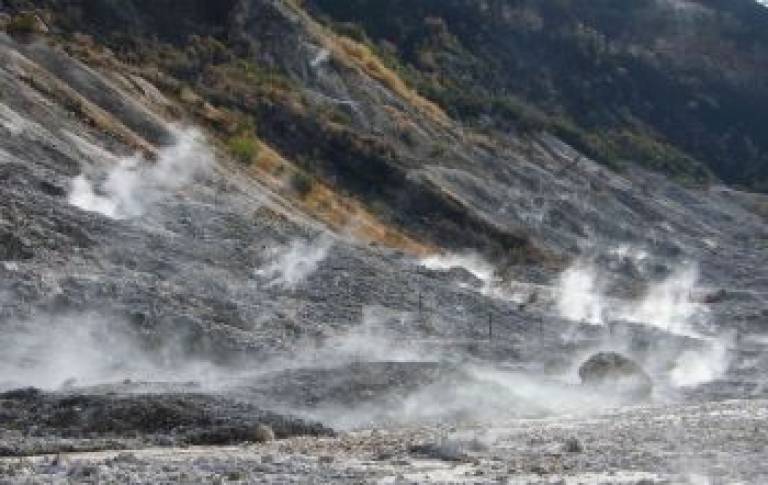Journey to the Centre of a Volcano
16 September 2009
UCL Earth Scientists are poised to unlock the secrets inside a volcano

The International Continental Drilling Programme (ICDP) has confirmed its support for a project to drill into the heart of an active volcano. The site chosen for the study is Campi Flegrei, a volcanic caldera immediately west of Naples in Southern Italy.
UCL Earth Sciences is a lead member in this international vanguard project, which will be co-ordinated by the INGV-Vesuvius Observatory. Due to start in 2010, drilling will extend to depths of 4 km, in order to penetrate through the caldera's near-surface geothermal system and to reach expected sites of magma intrusion.
The borehole will allow geophysical and geochemical sensors to be deployed to new depths, while the rock recovered from the drilling will help to define the physical properties of the caldera. The data will be combined to produce an enhanced 3D map of the caldera's interior, as well as new evaluations of ongoing crustal deformation in the caldera. The results will provide essential information for reducing the volcanic risk to Campi Flegrei's population of more than 1 million and for exploiting volcanic heat as geothermal energy. The hostile environment below ground will also challenge new technologies to protect the deep sensors. A successful programme, therefore, will not only enhance the quality of life in Campi Flegrei, but will also provide a launch-pad for applying new technology worldwide.
For more information, contact Dr Christopher Kilburn at c.kilburn@ucl.ac.uk.
Image: Smouldering volcano. The crater at Solfatara, near Pozzuoli, continues to degas some 3,500 years after it was formed. The ICDP Drilling Project will help efforts to forecast when the next eruption is due. (Photo: C.R.J. Kilburn.)
What is a caldera?
Large calderas are produced by the most devastating volcanic eruptions on Earth. They are giant depressions, often tens of kilometres across, formed during the eruption of hundreds to thousands of cubic kilometres of magma - enough to bury the United Kingdom to depths of a metre or more.
After they have formed, large calderas feed eruptions with more conventional volumes of cubic kilometres or less. Although smaller than the caldera-forming event, the later eruptions can destroy up to hundreds of square kilometres.
Unrest in Campi Flegrei.
The dominant caldera in Campi Flegrei was formed about 15,600 years ago, during eruption of the Neapolitan Yellow Tuff. At least 60 smaller eruptions have occurred since then. The last eruption, in 1538, coincided with a 100-year interval of intermittent ground uplift. A similar uplift has been developing since 1968 and so, with a population exceeding 1 million, Campi Flegrei is in the top rank of the world's threatening volcanoes. At the same time, the caldera boasts an active geothermal system, in which heat from deep magma is being circulated through near-surface aquifers. A tantalizing prospect thus exists of extracting renewable energy for Campi Flegrei and its metropolitan neighbour, Naples.
Want to know more?
Bellucci, F, Woo, J, Kilburn, CRJ, Rolandi, G. (2006) Ground deformation at Campi Flegrei, Italy: implications for hazard assessment. In, Troise, C, De Natale, G, Kilburn, CRJ (eds) Mechanisms of activity and unrest at large calderas. Geological Society Special Publication 269
 Close
Close

